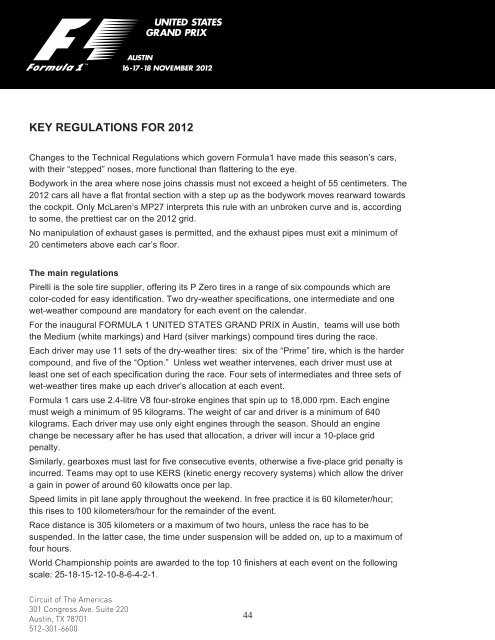Photographer Windows Map F N C E G H J B D A K L M
Photographer Windows Map F N C E G H J B D A K L M
Photographer Windows Map F N C E G H J B D A K L M
Create successful ePaper yourself
Turn your PDF publications into a flip-book with our unique Google optimized e-Paper software.
KEY REGULATIONS FOR 2012<br />
Changes to the Technical Regulations which govern Formula1 have made this season’s cars,<br />
with their “stepped” noses, more functional than flattering to the eye.<br />
Bodywork in the area where nose joins chassis must not exceed a height of 55 centimeters. The<br />
2012 cars all have a flat frontal section with a step up as the bodywork moves rearward towards<br />
the cockpit. Only McLaren’s MP27 interprets this rule with an unbroken curve and is, according<br />
to some, the prettiest car on the 2012 grid.<br />
No manipulation of exhaust gases is permitted, and the exhaust pipes must exit a minimum of<br />
20 centimeters above each car’s floor.<br />
The main regulations<br />
Pirelli is the sole tire supplier, offering its P Zero tires in a range of six compounds which are<br />
color-coded for easy identification. Two dry-weather specifications, one intermediate and one<br />
wet-weather compound are mandatory for each event on the calendar.<br />
For the inaugural FORMULA 1 UNITED STATES GRAND PRIX in Austin, teams will use both<br />
the Medium (white markings) and Hard (silver markings) compound tires during the race.<br />
Each driver may use 11 sets of the dry-weather tires: six of the “Prime” tire, which is the harder<br />
compound, and five of the “Option.” Unless wet weather intervenes, each driver must use at<br />
least one set of each specification during the race. Four sets of intermediates and three sets of<br />
wet-weather tires make up each driver’s allocation at each event.<br />
Formula 1 cars use 2.4-litre V8 four-stroke engines that spin up to 18,000 rpm. Each engine<br />
must weigh a minimum of 95 kilograms. The weight of car and driver is a minimum of 640<br />
kilograms. Each driver may use only eight engines through the season. Should an engine<br />
change be necessary after he has used that allocation, a driver will incur a 10-place grid<br />
penalty.<br />
Similarly, gearboxes must last for five consecutive events, otherwise a five-place grid penalty is<br />
incurred. Teams may opt to use KERS (kinetic energy recovery systems) which allow the driver<br />
a gain in power of around 60 kilowatts once per lap.<br />
Speed limits in pit lane apply throughout the weekend. In free practice it is 60 kilometer/hour;<br />
this rises to 100 kilometers/hour for the remainder of the event.<br />
Race distance is 305 kilometers or a maximum of two hours, unless the race has to be<br />
suspended. In the latter case, the time under suspension will be added on, up to a maximum of<br />
four hours.<br />
World Championship points are awarded to the top 10 finishers at each event on the following<br />
scale: 25-18-15-12-10-8-6-4-2-1.<br />
Circuit of The Americas<br />
301 Congress Ave. Suite 220<br />
Austin, TX 78701<br />
512-301-6600<br />
44<br />
44


